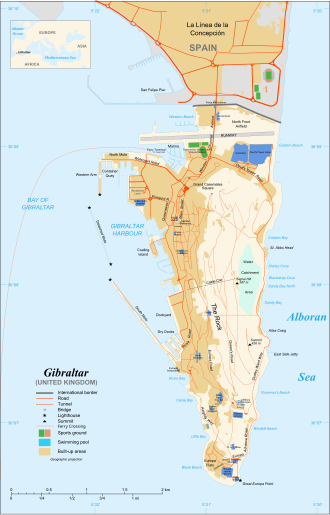Rock of Gibraltar






Rock of Gibraltar
The Rock of Gibraltar is a monolithic limestone promontory located in the British overseas territory of Gibraltar, near the southwestern tip of Europe on the Iberian Peninsula. It is also known as the Jabal Ṭāriq (جبل طارق) in Arabic, from which the name of the territory is derived. The Rock of Gibraltar is a landmark of the region and has been a symbol of strength and resilience throughout history.
Geography[edit]
The Rock of Gibraltar stands at the gateway to the Mediterranean Sea, overlooking the Strait of Gibraltar and the northern coast of Africa. It rises to a height of 426 meters (1,398 feet) and is primarily composed of Jurassic limestone. This limestone is home to a network of caves and tunnels, both natural and man-made, which have played significant roles throughout Gibraltar's history.
History[edit]
The history of the Rock of Gibraltar is as storied as it is long. It was known as one of the Pillars of Hercules in ancient times, marking the limit to the known world. The Rock's strategic importance was recognized early on, with evidence of human habitation dating back to the Neanderthals. It has been a focal point for military operations over the centuries due to its strategic position at the entrance to the Mediterranean.
In 711, it was captured by the Moorish leader Tariq ibn-Ziyad, from whom its name is derived. The Rock was later reclaimed by the Spanish in 1462. However, its most significant historical event occurred in 1704 during the War of the Spanish Succession when Anglo-Dutch forces captured Gibraltar. The Treaty of Utrecht in 1713 ceded Gibraltar to Britain, and it has remained under British control since, despite numerous Spanish attempts to reclaim it.
Ecology[edit]
The Rock of Gibraltar is also known for its rich biodiversity, particularly its population of Barbary macaques, the only wild monkeys found in Europe. These macaques are a major tourist attraction and symbol of Gibraltar. The Rock's unique ecology supports a variety of plants and animals, some of which are endemic to the region.
Economy and Tourism[edit]
Tourism is a significant aspect of Gibraltar's economy, with the Rock of Gibraltar being a major attraction. Visitors are drawn to its panoramic views, historical sites, and the famous Barbary macaques. The Upper Rock Nature Reserve offers walking trails, the Moorish Castle, and the Great Siege Tunnels, among other attractions.
Cultural Significance[edit]
The Rock of Gibraltar has become a symbol of solidity and reliability, often referred to in the saying "solid as the Rock of Gibraltar." Its image has been used in marketing and branding worldwide, most notably by financial institutions.
See Also[edit]
Ad. Transform your life with W8MD's Budget GLP-1 injections from $75


W8MD offers a medical weight loss program to lose weight in Philadelphia. Our physician-supervised medical weight loss provides:
- Weight loss injections in NYC (generic and brand names):
- Zepbound / Mounjaro, Wegovy / Ozempic, Saxenda
- Most insurances accepted or discounted self-pay rates. We will obtain insurance prior authorizations if needed.
- Generic GLP1 weight loss injections from $75 for the starting dose.
- Also offer prescription weight loss medications including Phentermine, Qsymia, Diethylpropion, Contrave etc.
NYC weight loss doctor appointmentsNYC weight loss doctor appointments
Start your NYC weight loss journey today at our NYC medical weight loss and Philadelphia medical weight loss clinics.
- Call 718-946-5500 to lose weight in NYC or for medical weight loss in Philadelphia 215-676-2334.
- Tags:NYC medical weight loss, Philadelphia lose weight Zepbound NYC, Budget GLP1 weight loss injections, Wegovy Philadelphia, Wegovy NYC, Philadelphia medical weight loss, Brookly weight loss and Wegovy NYC
|
WikiMD's Wellness Encyclopedia |
| Let Food Be Thy Medicine Medicine Thy Food - Hippocrates |
Medical Disclaimer: WikiMD is not a substitute for professional medical advice. The information on WikiMD is provided as an information resource only, may be incorrect, outdated or misleading, and is not to be used or relied on for any diagnostic or treatment purposes. Please consult your health care provider before making any healthcare decisions or for guidance about a specific medical condition. WikiMD expressly disclaims responsibility, and shall have no liability, for any damages, loss, injury, or liability whatsoever suffered as a result of your reliance on the information contained in this site. By visiting this site you agree to the foregoing terms and conditions, which may from time to time be changed or supplemented by WikiMD. If you do not agree to the foregoing terms and conditions, you should not enter or use this site. See full disclaimer.
Credits:Most images are courtesy of Wikimedia commons, and templates, categories Wikipedia, licensed under CC BY SA or similar.
Translate this page: - East Asian
中文,
日本,
한국어,
South Asian
हिन्दी,
தமிழ்,
తెలుగు,
Urdu,
ಕನ್ನಡ,
Southeast Asian
Indonesian,
Vietnamese,
Thai,
မြန်မာဘာသာ,
বাংলা
European
español,
Deutsch,
français,
Greek,
português do Brasil,
polski,
română,
русский,
Nederlands,
norsk,
svenska,
suomi,
Italian
Middle Eastern & African
عربى,
Turkish,
Persian,
Hebrew,
Afrikaans,
isiZulu,
Kiswahili,
Other
Bulgarian,
Hungarian,
Czech,
Swedish,
മലയാളം,
मराठी,
ਪੰਜਾਬੀ,
ગુજરાતી,
Portuguese,
Ukrainian
